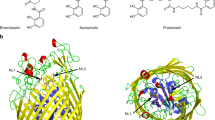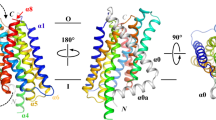Abstract
The first crystal structure of the iron-transporter ferric ion-binding protein from Haemophilus influenzae (hFBP), at 1.6 Å resolution, reveals the structural basis for iron uptake and transport required by several important bacterial pathogens. Paradoxically, although hFBP belongs to a protein superfamily which includes human transferrin, iron binding in hFBP and transferrin appears to have developed independently by convergent evolution. Structural comparison of hFBP with other prokaryotic periplasmic transport proteins and the eukaryotic transferrins suggests that these proteins are related by divergent evolution from an anion-binding common ancestor, not from an iron-binding ancestor. The iron binding site of hFBP incorporates a water and an exogenous phosphate ion as iron ligands and exhibits nearly ideal octahedral metal coordination. FBP is highly conserved, required for virulence, and is a nodal point for free iron uptake in several Gram-negative pathogenic bacteria, thus providing a potential target for broad-spectrum antibacterial drug design against human pathogens such as H. influenzae, Neisseria gonorrhoeae, and Neisseria meningitidis.
This is a preview of subscription content, access via your institution
Access options
Subscribe to this journal
Receive 12 print issues and online access
$189.00 per year
only $15.75 per issue
Buy this article
- Purchase on Springer Link
- Instant access to full article PDF
Prices may be subject to local taxes which are calculated during checkout
Similar content being viewed by others
References
Crosa, J.H. The relationship of plasmid-mediated iron transport and bacterial virulence. Annu. Rev. Microbiol. 38, 69–89 (1984).
Weinberg, E.D. Iron withholding: A defense against infection and neoplasia. Physiol. Rev. 64(1), 65–102 (1984).
Mietzner, T.A., Tencza, S.B., Vaughan, K.G., Adhikari, P.A. & Nowalk, A.J. Iron(III) periplasm-to-cytosol transporters of gram-negative pathogens. Curr. Topics Microbiol. Immunol. in the press (1997).
Adhikari, P. et al. Biochemical characterization of a Haemophilus influenzae periplasmic iron transport operon. J. Biol. Chem. 270, 25142–25149 (1995).
Tam, R. & Saier, M.H.J. Structural, functional, and evolutionary relationships among extracellular solute-binding receptors of bacteria. Microbiol. Rev. 57, 320–346 (1993).
Anderson, B.F. et al. Structure of human lactoferrin at 3.2 Å resolution. Proc. Natl. Acad. Sci, USA 84, 1769–1773 (1987).
Bailey, S. et al. Molecular structure of serum transferrin at 3.3 Å resolution. Biochemistry 27, 5804–5812 (1988).
Pflugrath, J. & Quiocho, F. Sulphate sequestered in the sulphate-binding protein of Salmonella typhimurium is bound solely by hydrogen bonds. Nature 314, 257–260 (1985).
Adams, M.D. & Oxender, D.L. Bacterial periplasmic binding protein tertiary structures. J. Biol. Chem. 264(27), 15739–15742 (1989).
Quiocho, F.A. Atomic structures of periplasmic binding proteins and the high-affinity active transport systems in bacteria. Phil. Trans, Royal Soc. London B326(1236), 341–351 (1990).
Nowalk, A.J., Tencza, S.B. & Mietzner, T.A. Coordination of iron by the ferric iron-binding protein of pathogenic Neisseria is homologous to the transferrins. Biochemistry. 33(43), 12769–12775 (1994).
Morse, S., Chen, C., Le Faou, A. & Mietzner, T.A potential role for the major iron regulated protein expressed by pathogenic Neisseria spp. Rev. Infect. Dis. 10(supp), 306–310 (1988).
Luecke, H. & Quiocho, F.A. High specificity of a phosphate transport protein determined by hydrogen bonds. Nature 347, 402–406 (1990).
Wang, Z., Choudhary, A., Ledvina, P.S. & Quiocho, F.A. Fine tuning the specificity of the periplasmic phosphate transport receptor: site-directed mutagenesis, ligand binding, and crystallographic studies. J. Biol. Chem. 269, 25091–25094 (1994).
Baker, E.N., Rumball, S.V. & Anderson, B.F. Transferrins: insights into structure and function from studies on lactoferrin. TIBS 12, 350–353 (1987).
Mietzner, T.A., Barnes, R.C., Jeanlouis, Y.A., Shafer, W.M. & Morse, S.A. Distribution of an antigenically related iron-regulated protein among the Neisseria-spp. Infection and Immunity. 51, 60–68 (1986).
Dewan, J.C., Mikami, B., Hirose, M. & Sacchettini, J.C. Structural evidence for a pH-sensitive dilysine trigger in the hen ovotransferrin N-lobe: implications for transferrin iron release. Biochemistry. 32, 11963–11968 (1993).
Berkowitz, F. Antibiotic resistance in bacteria. Southern Medical Journal 88, 797–804 (1995).
Knapp, J., Fox, K., Trees, D. & Wittington, W. Fluoroquinolone resistance in Neisseria gonorrhoeae. Emerging Infectious Diseases 3, 33–40 (1997).
Ho, S., Hunt, H., Horton, R., Pullen, J. & Pease, L. Site-directed mutagenesis by overlap extension using the polymerase chain reaction. Gene 77, 51–59 (1989).
McRee, D.E. A visual protein crystallographic software system for X11/Xview. J. Mol. Graphics 10, 44–46 (1992).
Furey, W. & Swaminathan, S. Phases: A program package for the processing and analysis of diffraction data from macromolecules. In: ACA Meeting Abstracts (1990).
Cowtan, K.D. & Main, P. Phase combination and cross validation in iterated density-modification calculations. Acta Crystallogr. D52, 43–48 (1996).
Tronrud, D., Ten Eyck, L. & Matthews, B. An efficient general-purpose least-squares refinement program for macromolecular structures. Acta Crystallogr. A48, 912–916 (1987).
Brünger, A.T. Assessment of phase accuracy by cross validation: the free R value. Methods and applications. Acta Crystallogr. D49, 24–36 (1993).
Anderson, B., Baker, H., Norris, G., Rice, D. & Baker, E. Structure of human lactoferrin: Crystallographic structure analysis and refinement at 2.8 Å resolution. J. Mol. Biol. 209, 711–734 (1989).
Read, R.J. Improved Fourier coefficients for maps using phases from partial structures with errors. Acta Crystallogr. A42, 140–149 (1986).
Day, C.L., Anderson, B.F., Tweedie, J.W. & Baker, E.N. Structure of the recombinant N-terminal lobe of human lactoferrin at 2.0 Å resolution. J. Mol. Biol. 232, 1084–1100 (1993).
Sarra, R., Garratt, R., Gorinsky, B., Jhoti, H. & Lindley, P. High resolution X-ray studies on rabbit serum transferrin. Preliminary structure analysis of the amino-terminal half-molecule at 2.3 Å resolution. Acta Crystallogr. B46, 763–771 (1990).
Bacon, D. & Anderson, W. A fast algorithm of rendering space-filling molecule pictures. Journal of Molecular Graphics 6, 219–220 (1988).
Merritt, E. & Murphy, M. Raster3d version 2.0, a program for photorealistic molecular graphics. Acta Crystallogr. D50, 869–873 (1994).
Author information
Authors and Affiliations
Corresponding author
Rights and permissions
About this article
Cite this article
Bruns, C., Nowalk, A., Arvai, A. et al. Structure of Haemophilus influenzae Fe+3-binding protein reveals convergent evolution within a superfamily. Nat Struct Mol Biol 4, 919–924 (1997). https://doi.org/10.1038/nsb1197-919
Received:
Accepted:
Published:
Issue Date:
DOI: https://doi.org/10.1038/nsb1197-919
This article is cited by
-
Exoproteome analysis of Pseudomonas aeruginosa response to high alkane stress
Archives of Microbiology (2024)
-
Carbonate-sensitive phytotransferrin controls high-affinity iron uptake in diatoms
Nature (2018)
-
One origin for metallo-β-lactamase activity, or two? An investigation assessing a diverse set of reconstructed ancestral sequences based on a sample of phylogenetic trees
Journal of Molecular Evolution (2014)
-
Molecular details of ligand selectivity determinants in a promiscuous β-glucan periplasmic binding protein
BMC Structural Biology (2013)
-
Complete genome sequence and metabolic potential of the quinaldine-degrading bacterium Arthrobacter sp. Rue61a
BMC Genomics (2012)



